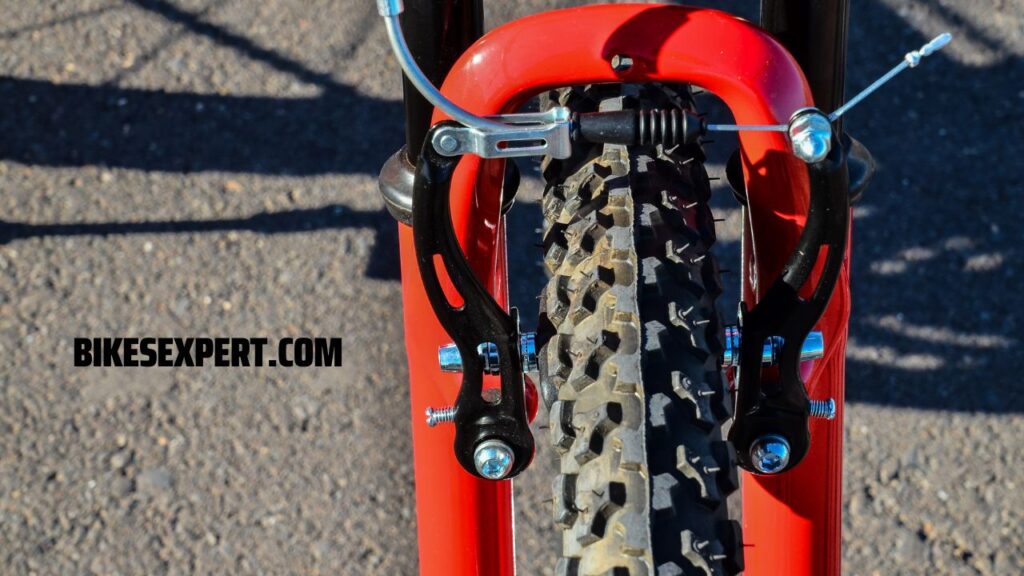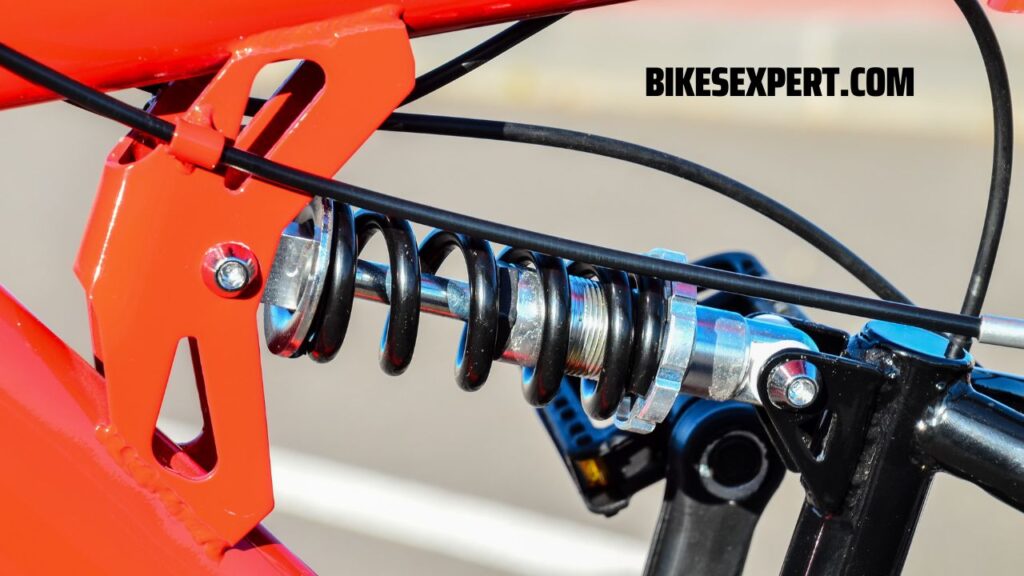If you’re a mountain biker, you know that having the right suspension setup can make all the difference in your ride.
Properly setting up your mountain bike suspension can help you tackle rough terrain, improve your speed and efficiency, and minimize fatigue.
However, with so many options and settings available, the process of setting up your suspension can be overwhelming. In this article, we’ll walk you through the steps to properly set up your mountain bike suspension.
Another post that will interest you is about How To Pack And Ship A Mountain Bike? (Pro Guide Of Bike Shipping).
Set Up Mountain Bike Suspension

Step 1: Set Your Sag
Sag is the amount of travel your suspension uses when you’re sitting on the bike. To set your sag, you’ll need to find the recommended percentage for your bike’s rear suspension and fork.
This information can usually be found in your bike’s manual or on the manufacturer’s website. Once you know the recommended sag, you’ll need a shock pump to adjust the pressure in your shock and fork.
To Set Your Sag, Follow These Steps:
- Sit on your bike in your normal riding position, with your weight evenly distributed.
- Have someone measure the distance between the o-ring on your shock and the shock body.
- Get off your bike and adjust the pressure in your shock and fork using the shock pump until the o-ring sits at the recommended sag percentage.
- Repeat the process until you get the correct sag percentage.
Step 2: Adjust Your Rebound
Rebound is the speed at which your suspension returns to its original position after being compressed.
It’s important to have your rebound set correctly to ensure that your suspension is able to keep up with the terrain you’re riding on.
To Adjust Your Rebound, Follow These Steps:
- Find the rebound adjustment knob on your shock and fork.
- Turn the knob all the way in one direction to feel the maximum amount of rebound.
- Turn the knob all the way in the opposite direction to feel the minimum amount of rebound.
- Set the knob to a midpoint between the two extremes.
- Test ride your bike to see how the rebound feels.
- If the rebound is too slow, turn the knob towards the maximum amount of rebound.
- If the rebound is too fast, turn the knob towards the minimum amount of rebound.
Step 3: Adjust Your Compression
Compression is the amount of force required to compress your suspension. Adjusting your compression can help you fine-tune your suspension to your riding style and the terrain you’re riding on.
To Adjust Your Compression, Follow These Steps:
- Find the compression adjustment knob on your shock and fork.
- Turn the knob all the way in one direction to feel the maximum amount of compression.
- Turn the knob all the way in the opposite direction to feel the minimum amount of compression.
- Set the knob to a midpoint between the two extremes.
- Test ride your bike to see how the compression feels.
- If the compression is too hard, turn the knob towards the minimum amount of compression.
- If the compression is too soft, turn the knob towards the maximum amount of compression.
Step 4: Fine-Tune Your Settings
Once you’ve set your sag, rebound, and compression, it’s time to fine-tune your settings for your riding style and the terrain you’re riding on.
This can take some trial and error, so be patient and don’t be afraid to make adjustments as you go.
Here Are Some Things To Consider When Fine-tuning Your Settings:
- Your weight and riding style: If you’re a heavier rider or ride more aggressively, you may need to adjust your settings accordingly.
- The terrain you’re riding on: If you’re riding on rougher terrain, you may need to increase your compression and rebound to handle the bumps and drops.
- Your bike’s suspension design: Different suspension designs may require different settings, so be sure to consult
How To Determine The Correct Suspension Pressure For Your Vehicle?

Driving a car with poorly inflated tires can be dangerous, not to mention it can reduce the vehicle’s performance and fuel efficiency. This is why it is important to ensure that your car’s suspension system is well-maintained, and the correct pressure is maintained in the tires. However, determining the appropriate pressure for your vehicle’s suspension can be a daunting task, especially for novice drivers.
- Understanding the Suspension System
The suspension system of a vehicle is responsible for maintaining the smoothness and stability of the ride. It consists of various components, including springs, shock absorbers, and struts. The suspension system’s primary function is to absorb the shocks and vibrations from the road surface, allowing the vehicle to handle corners and bumps while keeping the passengers comfortable.
- Why is Suspension Pressure Important?
The pressure in your vehicle’s suspension system is critical for maintaining the car’s performance and safety. Insufficient pressure can cause the suspension to bottom out or fail to absorb the shocks and vibrations from the road, which can lead to a bumpy and uncomfortable ride. On the other hand, over-inflated tires can make the car unstable, increase the risk of tire blowouts, and reduce the vehicle’s fuel efficiency.
- How to Determine the Correct Suspension Pressure
The first step in determining the correct suspension pressure is to refer to the vehicle owner’s manual. This document should provide you with a comprehensive guide on the recommended tire pressure for your vehicle. You can also find this information on the tire’s sidewall, which indicates the maximum tire pressure.
- Factors Affecting Suspension Pressure
Several factors can affect the suspension pressure, including the weight of the vehicle, the type of road surface, and the driving style. Heavier vehicles require higher suspension pressure than lighter ones, and rough terrain requires higher suspension pressure than smooth roads. Similarly, aggressive driving styles require higher suspension pressure than calm and relaxed driving.
- The Importance of Regular Maintenance
Regular maintenance is crucial for keeping your suspension system in optimal condition. This includes checking the tire pressure regularly, replacing worn-out suspension components, and aligning the wheels. Proper maintenance can ensure that the suspension system operates at peak efficiency and can significantly extend its lifespan.
Frequently Asked Questions [FAQs]
For your further inquiry, you may check out this section of the article. Here, we are going to answer some of the most commonly asked questions regarding “How To Set Up Mountain Bike Suspension?”
Q. How Often Should I Service My Suspension?
A. It depends on how frequently you ride and the type of terrain you ride on. Generally, it is recommended to service your suspension every 50-100 hours of riding.
Q: What Is Sag?
A: Sag is the amount of suspension travel used when you sit on your bike. It’s important to set your sag correctly to ensure optimal suspension performance.
Q: Can I Set Up My Suspension Myself, Or Should I Consult A Professional?
A: You can set up your suspension yourself, but if you’re unsure or uncomfortable, it’s always a good idea to consult with a professional bike mechanic.
Q. How Do I Know If My Suspension Is Set Up Correctly?
A. You should check the sag and adjust the rebound and compression damping settings to match your weight and riding style. If your bike feels comfortable and handles well, your suspension is set up correctly.

Conclusion
Having the right suspension setup is essential for a comfortable and safe mountain biking experience.
By following the steps outlined in this guide and regularly maintaining your suspension, you can ensure that your bike performs at its best.
Remember to adjust your suspension settings to match your weight and riding style and to regularly inspect your suspension for damage or wear. Happy riding!
Also, you have to check out my post on What Protective Gear Do I Need For Mountain Biking?




